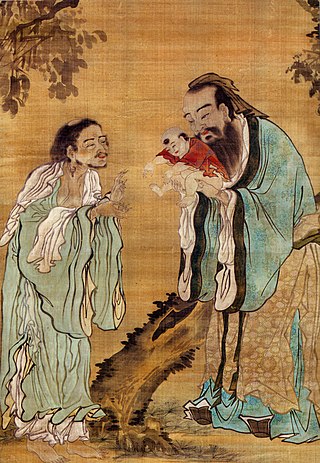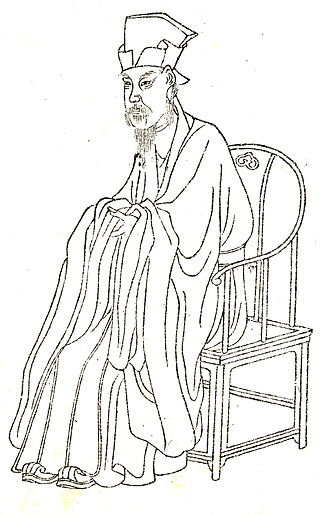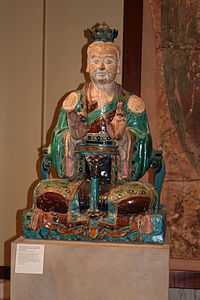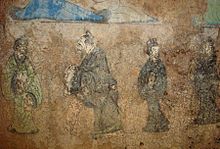This page lists some links to ancient philosophy, namely philosophical thought extending as far as early post-classical history.

Confucianism, also known as Ruism or Ru classicism, is a system of thought and behavior originating in ancient China, and is variously described as a tradition, philosophy, religion, theory of government, or way of life. Confucianism developed from teachings of the Chinese philosopher Confucius (551–479 BC), during a time that was later referred to as the Hundred Schools of Thought era. Confucius considered himself a transmitter of cultural values inherited from the Xia (c. 2070–1600 BC), Shang (c. 1600–1046 BC), and Western Zhou (c. 1046–771 BC) dynasties. Confucianism was suppressed during the Legalist and autocratic Qin dynasty (221–206 BC), but survived. During the Han dynasty, Confucian approaches edged out the "proto-Taoist" Huang–Lao as the official ideology, while the emperors mixed both with the realist techniques of Legalism.

Taoism or Daoism is a diverse philosophical and religious tradition indigenous to China, emphasizing harmony with the Tao 道. With a range of meaning in Chinese philosophy, translations of Tao include 'way', 'road', 'path', or 'technique', generally understood in the Taoist sense as an enigmatic process of transformation ultimately underlying reality. Taoist thought has informed the development of various practices within the Taoist tradition and beyond, including forms of meditation, astrology, qigong, feng shui, and internal alchemy. A common goal of Taoist practice is self-cultivation, a deeper appreciation of the Tao, and more harmonious existence. Taoist ethics vary, but generally emphasize such virtues as effortless action, naturalness, simplicity, and the three treasures of compassion, frugality, and humility.
The Tao or Dao is the natural way of the universe, primarily as conceived in East Asian philosophy and religion. This seeing of life cannot be grasped as a concept. Rather, it is seen through actual living experience of one's everyday being. The concept is represented by the Chinese character 道, which has meanings including 'way', 'path', 'road', and sometimes 'doctrine' or 'principle'.
Eastern philosophy includes the various philosophies that originated in East and South Asia, including Chinese philosophy, Japanese philosophy, Korean philosophy, and Vietnamese philosophy, which are dominant in East Asia; and Indian philosophy, which are dominant in South Asia, Southeast Asia, Tibet, Japan and Mongolia.

Zhu Xi, formerly romanized Chu Hsi, was a Chinese calligrapher, historian, philosopher, poet, and politician of the Southern Song dynasty. Zhu was influential in the development of Neo-Confucianism. He contributed greatly to Chinese philosophy and fundamentally reshaped the Chinese worldview. His works include his editing of and commentaries to the Four Books, his writings on the process of the 'investigation of things', and his development of meditation as a method for self-cultivation.
The Hundred Schools of Thought were philosophies and schools that flourished during the late Spring and Autumn period and Warring States period. The term was not used to describe these different philosophies until Confucianism, Mohism, and Legalism were created. The era in which they flourished was one of turbulence in China, fraught with chaos and mass militarization, but where Chinese philosophy was developed and patronized by competing bureaucracies. This phenomenon has been called the Contention of a Hundred Schools of Thought.

Neo-Confucianism is a moral, ethical, and metaphysical Chinese philosophy influenced by Confucianism, which originated with Han Yu (768–824) and Li Ao (772–841) in the Tang dynasty, and became prominent during the Song and Ming dynasties under the formulations of Zhu Xi (1130–1200). After the Mongol conquest of China in the thirteenth century, Chinese scholars and officials restored and preserved neo-Confucianism as a way to safeguard the cultural heritage of China.

In Chinese philosophy, the three teachings are Confucianism, Taoism, and Buddhism. The learning and the understanding of the three teachings are traditionally considered to be a harmonious aggregate within Chinese culture. Literary references to the "three teachings" by prominent Chinese scholars date back to the 6th century. The term may also refer to a non-religious philosophical grounds of aggregation as exemplified within traditional Chinese medicine.

Zhou Dunyi was a Chinese cosmologist, philosopher, and writer during the Song dynasty. He conceptualized the Neo-Confucian cosmology of the day, explaining the relationship between human conduct and universal forces. In this way, he emphasizes that humans can master their qi ("spirit") in order to accord with nature. He was a major influence to Zhu Xi, who was the architect of Neo-Confucianism. Zhou Dunyi was mainly concerned with Taiji and Wuji, the yin and yang, and the wu xing.

In the study of comparative religion, the East Asian religions or Taoic religions, form a subset of the Eastern religions, who originated in East Asia.
Li is a concept found in neo-Confucian Chinese philosophy. It refers to the underlying reason and order of nature as reflected in its organic forms.
Pan Pingge, was a notable Chinese philosopher during the late-Ming and early-Qing period.

Edo Neo-Confucianism, known in Japanese as Shushi-Gaku, refers to the schools of Neo-Confucian philosophy that developed in Japan during the Edo period. Neo-Confucianism reached Japan during the Kamakura period. The philosophy can be characterized as humanistic and rationalistic, with the belief that the universe could be understood through human reason, and that it was up to man to create a harmonious relationship between the universe and the individual. The 17th-century Tokugawa shogunate adopted Neo-Confucianism as the principle of controlling people and Confucian philosophy took hold. Neo-Confucians such as Hayashi Razan and Arai Hakuseki were instrumental in the formulation of Japan's dominant early modern political philosophy.
Chinese theology, which comes in different interpretations according to the Chinese classics and Chinese folk religion, and specifically Confucian, Taoist, and other philosophical formulations, is fundamentally monistic, that is to say it sees the world and the gods of its phenomena as an organic whole, or cosmos, which continuously emerges from a simple principle. This is expressed by the concept that "all things have one and the same principle". This principle is commonly referred to as Tiān 天, a concept generally translated as "Heaven", referring to the northern culmen and starry vault of the skies and its natural laws which regulate earthly phenomena and generate beings as their progenitors. Ancestors are therefore regarded as the equivalent of Heaven within human society, and therefore as the means connecting back to Heaven which is the "utmost ancestral father". Chinese theology may be also called Tiānxué 天學, a term already in use in the 17th and 18th centuries.
Taoist philosophy also known as Taology refers to the various philosophical currents of Taoism, a tradition of Chinese origin which emphasizes living in harmony with the Dào. The Dào is a mysterious and deep principle that is the source, pattern and substance of the entire universe.

Religion in the Song dynasty (960–1279) was primarily composed of three institutional religions: Confucianism, Taoism, and Buddhism, in addition to Chinese folk religion. The Song period saw the rise of Zhengyi Taoism as a state sponsored religion and a Confucian response to Taoism and Buddhism in the form of Neo-Confucianism. While Neo-Confucianism was initially treated as a heterodox teaching and proscribed, it later became the mainstream elite philosophy and the state orthodoxy in 1241.

Religious Confucianism is an interpretation of Confucianism as a religion. It originated in the time of Confucius with his defense of traditional religious institutions of his time such as the Jongmyo rites, and the ritual and music system.
Forms of religion in China throughout history have included animism during the Xia dynasty, which evolved into the state religion of the Shang and Zhou. Alongside an ever-present undercurrent of Chinese folk religion, highly literary, systematised currents related to Taoism and Confucianism emerged during the Spring and Autumn period. Buddhism began to influence China during the Han dynasty, and Christianity and Islam appeared during the Tang.
















